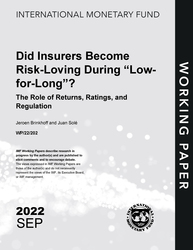
Did Insurers Become Risk-Loving During “Low-for-Long”? The Role of Returns, Ratings, and Regulation
Did Insurers Become Risk-Loving During “Low-for-Long”? The Role of Returns, Ratings, and Regulation
READ MORE...
Volume/Issue:
Volume 2022
Issue 202
Publication date: September 2022
ISBN: 9798400222399
$20.00
Add to Cart by clicking price of the language and format you'd like to purchase
Available Languages and Formats
| English |
Prices in red indicate formats that are not yet available but are forthcoming.
Topics covered in this book
This title contains information about the following subjects.
Click on a subject if you would like to see other titles with the same subjects.
Economics- Macroeconomics , Economics / General , Life Insurance sector , financial stability , credit ratings , bond revaluation , life insurance insurance company , bond portfolio , investment behavior , bond investor , Bonds , Insurance companies , Corporate bonds , Sovereign bonds , Bond ratings , Global
Summary
European life insurance companies are important bond investors and had traditionally played a stabilizing role in financial markets by pursuing “buy-and-hold” investment strategies. However, since the onset of the ultra-low interest rates era in 2008, observers noted a decline in the credit quality of insurers’ bond portfolios. The commonly-held explanation for this deterioration is that low returns pushed insurers to become more risk-taking. We argue that other factors—such as surging rating downgrades, bond revaluations, and regulatory changes—also played a key role. We estimate that rating changes, revaluations, and search for yield each account for about one-third each of the total deterioration in credit quality. This result has important policy implications as it reestablishes the view that insurers’ investment behavior tends to be passive through the cycle—rather than risk-seeking.
Copyright © 2010 - 2026
Powered by:
AIDC



